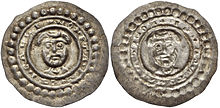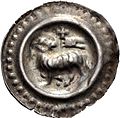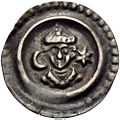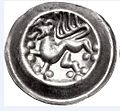
A bracteate is a flat, thin, single-sided gold medal worn as jewelry that was produced in Northern Europe predominantly during the Migration Period of the Germanic Iron Age. Bracteate coins are also known from the medieval kingdoms around the Bay of Bengal, such as Harikela and Mon city-states. The term is also used for thin discs, especially in gold, to be sewn onto clothing in the ancient world, as found for example in the ancient Persian Oxus treasure, and also later silver coins produced in central Europe during the Early Middle Ages.

The 'pfennig' or penny is a former German coin or note, which was the official currency from the 9th century until the introduction of the euro in 2002. While a valuable coin during the Middle Ages, it lost its value through the years and was the minor coin of the Mark currencies in the German Reich, West and East Germany, and the reunified Germany until the introduction of the euro. Pfennig was also the name of the subunit of the Danzig mark (1922–1923) and the Danzig gulden (1923–1939) in the Free City of Danzig.

Groschen a name for various coins, especially a silver coin used in various states of the Holy Roman Empire and other parts of Europe. The word is borrowed from the late Latin description of a tornose, a grossus denarius Turnosus, in English the "thick denarius of Tours". Groschen was frequently abbreviated in old documents to gl, whereby the second letter was not an l, but an abbreviation symbol; later it was written as Gr or g.
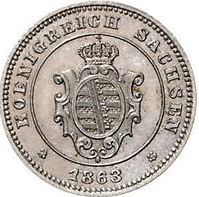
The Neugroschen was a Saxon Scheidemünze coin minted from 1841 to 1873 which had the inscription Neugroschen. This groschen, made of billon, was equivalent to the Prussian groschen but, unlike the latter, was divided not into 12, but into 10 pfennigs.

The history of Saxon coinage or Meissen-Saxon coinage comprises three major periods: the high medieval regional pfennig period, the late medieval pfennig period and the thaler period, which ended with the introduction of the mark in 1871/72. Rich silver deposits, which were discovered near Freiberg after the middle of the 12th century, helped Saxony to a leading position in German coinage.

A Schüsselpfennig, also Gehulchter Pfennig is so called due to the stamping technique which results in a concave, one-sided type of Pfennig coin. It was probably first minted in 1374 in the Palatinate. Small Schüsselpfennigs that had entered the Electorate of Saxony were referred to there as Näpfchenheller.
The Lilienpfennig was a type of Late Medieval pfennig from the German Free Imperial City of Strasbourg which was stamped on one side with the image of a fleur-de-lys.
The regional pfennig was a type of pfennig, a low denomination coin used in the Holy Roman Empire that began to appear in the 10th century after the period of the supra-regional pfennigs following the coin reform of the Emperor Charlemagne of Francia. With the increasing allocation of royal minting rights under the Münzregal to other mints, different types of pfennig emerged. The mints with their own minting rights included those cities that had attained a special degree of independence, in some cases even imperial immediacy. However, a localization of coinage was partly counteracted by a move by cities to form minting associations or Münzvereins, in which minting agreement standards for the weight and, above all, the fineness of coins were set. which must not be undercut in order to ensure unrestricted convertibility of the coins within the contract area. In later centuries, larger denominations of higher value were introduced, such as the groschen (grossus) and, in the Alpine region, the Kreuzer. The pfennig thus fell from being a major coin and currency money to a small Scheidemünze coin. Attempts at standardisation concentrated on the new, larger denominations and no longer on the pfennig, which basically remained a state coin of only regional significance. In Germany, the pfennig was only successfully unified again in the 19th century, initially through the Prussian small coinage reform of 1821 for the various small coins in the Prussian provinces, and then through the second Imperial Coin Act of 1873.
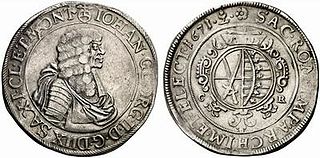
The Wechselthaler, also spelt Wechseltaler or Wechsel-Thaler, was minted in 1670 and 1671 in the Electorate of Saxony under Elector John George II (1656–1680) to the Wechselthaler or Burgundian thaler standard (861/1000 fineness). As the name suggests, the Wechselthaler and its subdivisions were intended as a currency to encourage Leipzig's trade with Hamburg and the Netherlands. The first coins from 1670 therefore bear the inscription WECHSELTHALER on the reverse. The Wechselthaler standard was only valid in Electoral Saxony in 1670 and 1671.

The Sachsenpfennig, sometimes called the Wendenpfennig or the Hochrandpfennig was a well-known coin of the pfennig type minted in the eastern part of the Stem Duchy of Saxony during the 10th and 11th centuries. It had an upturned perimeter and, next to the Otto Adelheid Pfennig was the most common pfennig type of its time. Sachsenpfennigs are the oldest coins minted in Saxony. Its different names represent a lack of clarity within mediaeval numismatics about the coin.

Mintmaster marks are often the initials of the mintmaster of a mint or small symbols for example at the size of the letters on a coin inscription to denote the coins made under his direction. With his mark, the mintmaster assumed responsibility for ensuing the coins issued by his mint were in accordance with the regulations. Mintmaster marks were used as early as the time of bracteate coinage in the Holy Roman Empire, but these can only rarely be deciphered. All mintmaster marks since the beginning of the minting of Thalers have been identified.

The Roter Seufzer, also called the Seufzer and Leipziger Seufzer, was the popular name of the inferior six-pfennig coin minted in huge quantities in 1701 and 1702 by the Prince-Elector of Saxony and King of Poland, Augustus the Strong (1694–1733). The name of these coins was due to the loss that the population suffered as a result of the coins which had a high copper content.
A Münzfuß is an historical term, used especially in the Holy Roman Empire, for an official minting or coinage standard that determines how many coins of a given type were to be struck from a specified unit of weight of precious metal. The Münzfuß, or Fuß ("foot") for short in numismatics, determined a coin's fineness, i.e. how much of a precious metal it would contain. Mintmaster Julian Eberhard Volckmar Claus defined the standard in his 1753 work, Kurzgefaßte Anleitung zum Probieren und Münzen, as follows: "The appropriate proportion of metals and the weight of the coin, measured according to their internal and external worth, or determined according to their quality, additives and fineness, number and weight, is called the Münzfuß."
As well as being the name of a coin, the Schilling was an historical unit in three areas of measurement: numbers, volume and weight. It can be regarded as a European measure, because it was used in Bohemia, Bavaria, Silesia, Austria and Lusatia.

The Guter Groschen, also Gutergroschen or Gutegroschen, abbreviation Ggr., is name of the groschen coin that was valued at 1⁄24 of a Reichsthaler from the end of the 16th century. It was called a "good groschen" to distinguish it from the lighter Mariengroschen, which was only valued at 1⁄36 Reichsthaler. The term Guter Groschen remained common until the middle of the 19th century.
A Großpfennig or Großer Pfennig was a Pomeranian pfennig coin of the 14th and 15th centuries. It also referred, in a more general sense, to any coin whose value was a multiple of the pfennig.

The Bauerngroschen, also Burgroschen, was a groschen minted in the Free Imperial City of Goslar from 1477 until at least 1490 and continued to circulate until the 16th century. On the obverse it depicts a coat of arms with an imperial eagle beneath a helmet with a crown and on the reverse Saints, Simon and Jude. The two apostles were thought by the people to be farmers due to the poor quality stamping of the coins, hence the name, Bauerngroschen.

From the Late Middle Ages the albus was a common currency in parts of the Holy Roman Empire, especially in the Rhineland. The name albus is Latin and means "white". Because of its higher silver content, this lighter coin differed in colour from the other inferior coins. This resulted in the names denarius albus, Weißpfennig or Rhenish groschen.
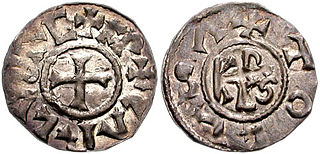
The Carolingian monetary system, also called the Carolingian coinage system or just the Carolingian system, was a currency structure introduced by Charlemagne in the late 8th century as part of a major reform, the effects of which subsequently dominated much of Europe, including Britain, for centuries. It is characterised by having three denominations in the ratio 1:20:240, the units of which went under different names in the different languages, but which corresponded to the Latin terms libra (pound), solidus (shilling) and denarius (penny).

A Stäbler or Stebler was a coin struck and issued by the city of Basle in Switzerland in 1373 after it had obtained minting rights. The coins depict the Basle staff, the coat of arms of the city of Basle. They are square in shape, struck on one side only and weigh about 0.15 grams of silver fine weight. The coin design appears in high relief, while the reverse remains blank and is referred to in numismatics as a bracteate.
